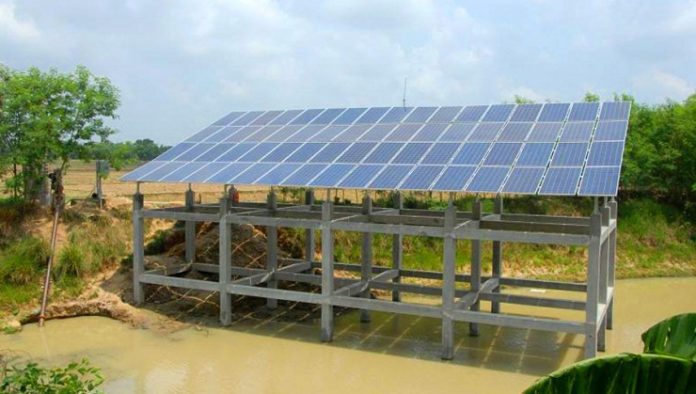RAJSHAHI, April 17, 2019 (BSS)-Solar pump irrigation has brought a new
dimension in agriculture in the drought-prone Barind tract benefiting its
people in many ways.
“Solar power irrigation is not only contributing to lessening pressure on
fossil fuel driven power supply but also reducing the gradually mounting
pressure on groundwater,” said Dev Dulal Dhali, Additional Director of
Department of Agriculture Extension (DAE).
More than 3,780 hectares of farming fields were brought under the
irrigation privileges contributing to yielding around 37,800 metric tonnes of
food grains and vegetables round the year.
Agriculturist Dhali says Barind Multipurpose Development Authority (BMDA)
has promoted the river water based solar power irrigation in the Barind area
in order to reducing pressure on underground water through increasing use of
surface water for irrigation round the year.
“We are getting water for irrigating our cropland round the year from
Sharmangla canal in Godagari upazila of the district,” said Aminul Islam, a
farmer of a nearby village.
He is now happy with canal water based irrigation in the current Boro rice
season. Nazrul Islam, 45, another farmer of Rajabari village, said canal
water contains humus which is important for soil fertility as well as
boosting crop yield.
“We are so much happy with getting scopes of irrigation using surface water
round the year,” he added.
Like them, canal water irrigation has made thousands of farmers happy in
the high Barind area as their dependence on deep tubewells and rainfall has
been reduced to some extent.
BMDA, the ever-largest irrigation providing state-owned entity in the
country’s northwest region, has installed 106 solar water pumps to provide
irrigation to farmlands in the drought-prone eight upazilas under Rajshahi,
Naogaon and Chapainawabganj districts.
Fifty-seven low lift pumps were also installed for lifting water from seven
points through pontoons in Padma, Mohananda and Atrai rivers under a three-
year project titled “Extension of Irrigation in Barind Area through
Conservation of Water in Canal”.
Under the Taka 116.13-crore project, 38.85-kilometer canals and seven ponds
were re-excavated for conservation of the water lifted from river till June
last, said Shamsul Huda, Superintending Engineer of BMDA and Director of the
project.
Besides, 83.5-kilometer pipelines were commissioned for transfusing the
lifted water to the canals while 181-kilometer pipelines for distributing the
preserved water in canals and ponds to the farming fields through the solar
pumps.
Various other need-based infrastructures like 3.5-kilometer retaining wall
for protection of conserved water, sixteen submerged weirs and three road-
crossing culverts were constructed for proper functioning of the irrigation
system.
Shamsul Huda sys the canal water improvement scheme has been implemented
for lessening the gradually mounting pressure on groundwater side by side
with popularizing the solar pump irrigation system among the farmers.
He adds more than 80,000 trees were transplanted on banks of the canals and
ponds which will ultimately help reduce carbon emission at a substantial
level and that is very important to face the adverse impact of climate change
in the vast Barind tract.
Ataur Rahman, Chairman of Badhair Union Parishad, said many of the hand-
driven tube wells become out of order during dry season when the deep tube-
wells remain functioning.
He said the odd situation poses a serious threat to the living and
livelihood condition of the people particularly the poor and ethnic minority.
So, there is no alternative of using river water to protect the aquifer.
Professor Chowdhury SarwarJahan of Department of Geology and Mining in
Rajshahi University said Barind area’s irrigation system is largely dependent
on underground water.
So, huge underground water is extracted for crop cultivation including
Irri-boro every year. He said there is no alternative but to promote surface
water based irrigation to protect the groundwater resources from further
degradation.



